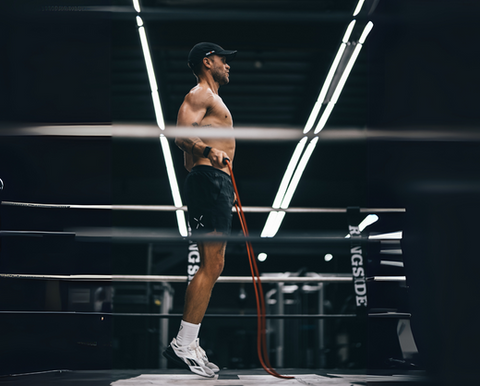How to Jump Rope Like a Boxer
Nov 20, 2024Devin Meek

Jumping rope is more than just a warm-up for boxers; it's a core part of boxing training that hones skills and builds endurance. If you’re a beginner aiming to boost agility or an athlete focused on refining footwork, learning how to jump rope like a boxer can impact your fitness routine positively. In this article, we’ll break down the benefits, essential techniques, and tips to help you start jumping rope with the precision and skill of a pro.
A 2022 study, A Comparison of Plyometric and Jump Rope Training Programs for Improving Punching Performance in Junior Amateur Boxers, examined how different lower-body training methods impact punching performance. In the study, twenty-four junior boxers, aged 12 to 18 and with several years of experience, followed either an 8-week plyometric or jump rope training program, practicing three times a week.
Both training methods yielded comparable improvements in lower-body strength—including jump power and rate of force development—as well as punching skills, particularly in reaction time, jab velocity, and peak ground reaction force from the rear leg. Although neither program significantly increased punch force, the findings suggest that plyometric and jump rope training are effective in building lower-body strength and power, which are key to developing stronger, faster punches in young boxers.
Jumping rope provides significant benefits for both boxers and fitness enthusiasts. From enhanced footwork to improved stamina, here’s why boxers swear by jump rope training:
By incorporating jump rope training, you’re not just following a routine—you’re building the foundations of strength, precision, and agility that boxers need in the ring.
Here’s a step-by-step breakdown of techniques you can use to jump rope like a boxer. Each step focuses on building your skills progressively, so you can skip with the smoothness and skill that boxers are known for.
Hold the rope handles lightly and focus on rotating the rope with your wrists, not your arms. Keep your elbows close to your body and generate movement from your wrists to create smaller, faster rotations. This control will help you build rhythm as you begin your jumps.
With your wrist movement established, practice swinging the rope over your head, letting it pass in front of your body. The key here is timing; aim to jump just as the rope is about to touch the ground in front of you. For an in-depth visual, check out our YouTube tutorial.
Begin by jumping with both feet, keeping your knees slightly bent. Focus on light, quick jumps that barely lift your feet off the ground—this minimizes impact on your joints while helping you sustain endurance.
Find a steady, consistent rhythm that allows you to maintain jumps without getting fatigued too quickly. Count out a beat in your head, or match it with a song to help keep your pacing.
The boxer shuffle is a signature move for boxers that involves alternating feet while you jump. Start by shifting weight between feet in a slight side-to-side motion with each jump. This helps boxers stay light on their feet and prepares you for more advanced footwork.
Once you’re comfortable with the basics, try adding more complex footwork, like double-unders and criss-crosses. These moves challenge your coordination and give you the agility edge that boxers need. For advanced tips, take a look at our guide to jump rope techniques.
High-knee jumps add an extra level of difficulty while enhancing core strength and endurance. Start with your regular jump, then transition into bringing your knees up toward your chest with each jump, alternating knees to build a quick, effective burn.
Ready to take your jump rope skills to the next level? Our Elite Jumps Jump Rope App just launched a brand-new course dedicated to Boxing Skills! This course is designed to help you master techniques like sideswings, the boxer step, and other advanced skills professional boxers use in their training. Download the app today and start perfecting the moves that make boxers so effective in the ring!
Boxers generally prefer lightweight, durable jump ropes that allow for fast rotation and smooth motion. A classic choice is a PVC speed rope, which offers a lightweight feel that encourages quick, agile footwork.
For beginners, using a slightly heavier rope, like our 1/2 lb heavy beaded rope or a 6mm PVC rope, can help slow down movements, giving you time to practice control and rhythm. When you’re ready to level up, we recommend transitioning to a boxer-specific jump rope for more dynamic training.
Boxers practice jump rope with a strong focus on timing, rhythm, and wrist rotation. By minimizing arm movement and concentrating on wrist action, they create faster, more controlled spins. Over time, this technique enables them to skip rapidly without losing rhythm, giving them the quickness and coordination that are vital in the ring.
 |
About the AuthorDevin Meek is the Director of Education for Elite Jumps. He's been a jump rope entertainer for over eighteen years and is a three-time world champion competitive jumper. Devin travels the country sharing his passion for the sport, giving jump rope workshops to schools, CrossFit gyms, and corporate wellness programs. |
10 Advanced Jump Rope Workout Techniques
Chottidao M, Kuo C-H, Tsai S-C, Hwang I-S, Lin J-J and Tsai Y-S (2022) A Comparison of Plyometric and Jump Rope Training Programs for Improving Punching Performance in Junior Amateur Boxers. Front. Bioeng. Biotechnol. 10:878527. doi: 10.3389/fbioe.2022.878527
We're all about equipping and encouraging people to take on big challenges, because we know the process of doing hard things helps us grow in character and capacity.
Frequently bought together
You may also like
0 Comments
There are no comments for this article. Be the first one to leave a message!